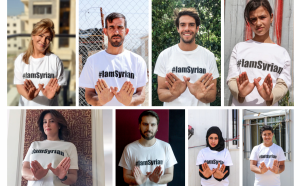Critique of a Social Media Campaign – Is There Power In a Hashtag?
I have always been interested in the growing prevalence and addiction to social media world-wide. Without a doubt it has become a very powerful tool, both for positive as well as negative change. For this critique I have opted to focus on one of the upsides to living in a very technologically savvy age, being that because we are all connected, it allows for larger discussion across countries, continents, and between people from all different backgrounds.
Whether its Snapchat, Instagram, Facebook, or twitter, one way to flag certain topics or create a catchy way to get something trending, is to use a hashtag. Just recently we’ve seen the success of this tactic embodied by the #MeToo campaign. By 4am the morning after it was introduced 200,000 tweets using the hashtag “metoo” were counted by twitter so when I turned to think about various social media campaigns that have addressed the current refugee and migrant crisis across the world, I was very interested to learn that while I had never heard of this particular campaign, there was indeed one addressing this very issue. The hashtag “IamSyrian” gained popularity not too long ago after the London Syria conference in February this past year and it encouraged Syrians to take to social media to share their stories and bring a human face to the ever growing mass displacement due to the war. The campaign was launched by the World Food Programme (WFP) at the conference and Gregory Barrow, the head of the WFP liaison office in London explained how being “five years into the crisis in Syria, and we have to work harder to keep the world engaged with the issues behind the conflict and the basic needs of the millions of Syrians whose lives have been turned upside-down” and how “#IamSyrian provides an opportunity for people to show solidarity by sharing the stories of ordinary men, women and children who have been affected by war and, by doing this, demonstrating that the world still cares” (WFP). So while the intended audience of the organization at first was targeted towards Syrians and Syrian refugees to participate in the campaign, once the stories were published and it started to gain some publicity, the intended audience shifted towards those more unaware of the current crisis and also those who would be able to donate to the cause. The campaign was set-up so that every month after the conference in February until the UN General Assembly in September, the WFP would launch different activities and stories which also leads me to believe that their intended audience was also members of the UN and those with the power to make actual policy changes.
Although there isn’t a total in terms of revenue generated for just the campaign months, right after the #IamSyrian was launched, German Chancellor Angela Merkel donated 570 million euros to the to the WFP to which the Executive Director of the United Nations World Food Programme responded, the new campaign, “#IamSyrian, calls on the world to empathize with the suffering of ordinary Syrians. Germany has just answered that call with a big commitment to support families who are being displaced at the rate of 50 families per hour. We thank you on their behalf” (WFP). So while the final numbers for the year still have not been released, the campaign was definitely successful in bringing funds in from at least one of the leaders that they were trying to reach specifically in attendance and entrenched in this issue at the UN General Assembly.
In terms of reaching the general population, the hashtag #IamSyrian on twitter, in total has been used 134,000 times, according to the website Brand24 which tracks hashtag uses strictly on the twitter app. While this may seem like a pretty good number, there were also a decent number of them used for various other things ranging from beauty tips to political messages. On the WFP website itself, at the end of each monthly group of narratives there is a button that says “enjoy” with the accompanying text “click enjoy if you relate to these stories, to express solidarity with their protagonists, or show admiration for their resilience.” I went through and got the numbers of how many people “enjoy”-ed each segment and I found that although people responded very well to the first two relative to their usual posts, the numbers steeply declined after that. For the first introductory article in February 359 people hit enjoy, March- 290, April- 132, May there where two different installations with 15 and 20, June three different with 20, 42, and 30 respectively, July 27, August three- 33, 10, and 52, coming to a close in September with 47. This aligned, unfortunately, quite well with what Gregory Barrow had said regarding the fact that as time goes on, we have to work harder to keep the world engaged with these issues. And while I think that this campaign was somewhat successful in reaching the Angela Merkels of the world and the UN basis that the WFP more commonly comes into contact with, they did not reach a very broad population outside of that. Likewise, they may have sparked some great discussion via social media- both on their website as well as other first-hand accounts that were shared directly on other platforms, but I felt the two were slightly disjointed – the powerful and moving personal stories gathering speed under the tag #IamSyrian, and the project that the WFP was trying to promote.
The first of the installments from the World Food Programme can be found at this link: https://panorama.wfp.org/iamsyrian-inas
Other site used: http://www.wfp.org/news/news-release/unprecedented-german-contribution-wfp-brings-hope-millions-syria-crisis
Recent Comments